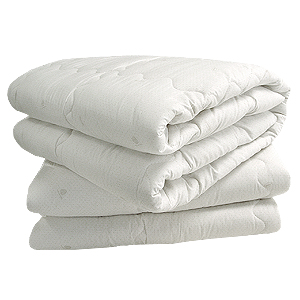Comforter
Comforter refers to a type of bedding used to keep the user warm while sleeping or resting. Traditionally, a comforter is a thick, quilted, fluffy blanket intended to sit atop the rest of the bed linen. Comforters are filled with layers of material including down feathers, wool, silk, or synthetic fibers like polyester batting, which are quilted or stitched to secure the filling and keep it evenly distributed. Unlike a duvet, the comforter only forms one piece of all of your bed linens. It is intended to sit on top of sheets and other blankets for extra warmth and decorative purposes. Many comforters have two distinct colors or patterns on either side, providing a reversible feature that allows for a quick and easy change in room decor.
Types of Comforters[edit | edit source]
Comforters come in a variety of materials and fillings, catering to different preferences and climates. The most common types include:
- Down Comforters: Filled with the soft and fine feathers found under the tougher exterior feathers of ducks or geese. Down comforters are prized for their softness, warmth, and lightweight properties.
- Down Alternative Comforters: Designed for those who are allergic to down or prefer not to use animal products. These comforters use synthetic fillings that mimic the feel of down but are often hypoallergenic.
- Wool Comforters: Known for their durability and natural temperature-regulating properties. Wool fillings can keep you warm in the winter and cool in the summer.
- Cotton Comforters: Preferred for their natural, breathable properties, making them ideal for warmer climates or for people who tend to sleep hot.
Choosing the Right Comforter[edit | edit source]
When selecting a comforter, consider the following factors:
- Warmth: The warmth of a comforter is determined by its fill power or the amount of space one ounce of down occupies. Higher fill power indicates more warmth.
- Weight: Some people prefer a heavier comforter that provides a sense of security, while others may opt for a lighter option.
- Size: Comforters come in standard bedding sizes such as twin, full, queen, and king. It's important to choose a size that fits your bed properly.
- Care: Depending on the materials, some comforters may require professional cleaning, while others are machine washable.
Care and Maintenance[edit | edit source]
Proper care can extend the life of a comforter, regardless of its type. Always follow the manufacturer's instructions for cleaning and maintenance. Generally, it is recommended to use a duvet cover to protect the comforter from dirt and spills. Regularly fluffing and airing out the comforter can help maintain its loft and freshness.
Environmental Considerations[edit | edit source]
With growing awareness of sustainability and animal welfare, many consumers are now considering the environmental impact of their comforter choices. Options such as organic cotton or recycled polyester fillings offer a more eco-friendly alternative to traditional materials.
| Comforter Resources | |
|---|---|
|
|
Search WikiMD
Ad.Tired of being Overweight? Try W8MD's physician weight loss program.
Semaglutide (Ozempic / Wegovy and Tirzepatide (Mounjaro / Zepbound) available.
Advertise on WikiMD
|
WikiMD's Wellness Encyclopedia |
| Let Food Be Thy Medicine Medicine Thy Food - Hippocrates |
Translate this page: - East Asian
中文,
日本,
한국어,
South Asian
हिन्दी,
தமிழ்,
తెలుగు,
Urdu,
ಕನ್ನಡ,
Southeast Asian
Indonesian,
Vietnamese,
Thai,
မြန်မာဘာသာ,
বাংলা
European
español,
Deutsch,
français,
Greek,
português do Brasil,
polski,
română,
русский,
Nederlands,
norsk,
svenska,
suomi,
Italian
Middle Eastern & African
عربى,
Turkish,
Persian,
Hebrew,
Afrikaans,
isiZulu,
Kiswahili,
Other
Bulgarian,
Hungarian,
Czech,
Swedish,
മലയാളം,
मराठी,
ਪੰਜਾਬੀ,
ગુજરાતી,
Portuguese,
Ukrainian
Medical Disclaimer: WikiMD is not a substitute for professional medical advice. The information on WikiMD is provided as an information resource only, may be incorrect, outdated or misleading, and is not to be used or relied on for any diagnostic or treatment purposes. Please consult your health care provider before making any healthcare decisions or for guidance about a specific medical condition. WikiMD expressly disclaims responsibility, and shall have no liability, for any damages, loss, injury, or liability whatsoever suffered as a result of your reliance on the information contained in this site. By visiting this site you agree to the foregoing terms and conditions, which may from time to time be changed or supplemented by WikiMD. If you do not agree to the foregoing terms and conditions, you should not enter or use this site. See full disclaimer.
Credits:Most images are courtesy of Wikimedia commons, and templates Wikipedia, licensed under CC BY SA or similar.
Contributors: Prab R. Tumpati, MD

